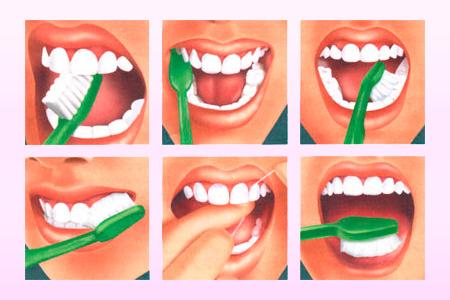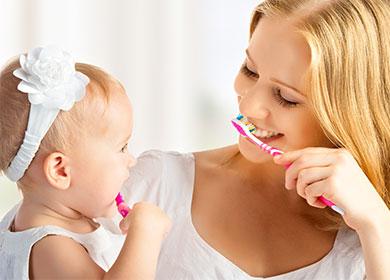The content of the article
Brushing your teeth with a brush is the main hygiene procedure that ensures their health. During the cleaning period, about 70% of the soft plaque formed at night and during the day on enamel is removed. Also, brushing methods include removing bacteria from the tongue, which helps eliminate bad odors. Dental floss is called to complete sanitary cleaning, with the help of which plaque from the interdental space is eliminated, and a dental elixir that has an antibacterial and refreshing effect.
The right technique
The technique for treating tooth surfaces is as follows.
- Rinse your toothbrush under running water.
- Apply a paste to the bristles. For an adult, “peas” of 1 cm wide are enough, for a child - 0.5 cm.
- Proper brushing starts with the outer surface of the upper painters. Position the brush head at an angle of 45 degrees towards them. Make short, soft movements, as if sweeping a coating with enamel.
- Similarly, clean the outside of the lower painters.
- Proceed to the inner surface of the upper teeth. To do this, place the brush perpendicular to the gum and move it back and forth.
- Continue cleaning the inside of the lower incisors. Perform similar movements.
- The next step in the standard method of cleaning teeth is to remove plaque from chewing surfaces. You can perform it in a circular motion or moving the brush back and forth.
- Clean your tongue - brush from root to tip, removing plaque. So you eliminate the appearance of an unpleasant odor.
- Close your lips and gently massage your gums with a brush.
- Rinse your mouth with water, then use a thread or rinse balm.
We suggest that you familiarize yourself with how to brush your teeth in the photo below.

We also recommend that you learn how to brush your teeth in the video.
Most popular questions
- How to brush your teeth in the morning: before meals or after?
Since the cleansing procedure involves the removal of food debris, dentists recommend performing it after a meal. But with regard to the first morning cleaning, there are nuances. So during sleep, a large amount of plaque forms on enamel, which is recommended to be cleaned before eating. Therefore, if you adhere to the regime of two-time brushing, perform this procedure before breakfast and after the last meal.
- How to brush your teeth so that they are white?
Daily cleaning is not able to make the enamel lighter. With regular plaque removal, it only preserves the natural color of your teeth, which by its nature cannot be white. Normal for enamel is a slightly yellowish tint (it is provided by the minerals included in its composition). And only professional dentist whitening, which is carried out by ZOOM photo-bleaching complexes or laser exposure, can significantly brighten the enamel.
- How long do you need to brush your teeth?
The total time of the hygiene procedure should be at least 120 seconds. For a shorter period, you will not have time to clean all the tooth surfaces with high quality. To learn how to withstand it, use a watch or a stopwatch. In a couple of weeks you can do without them.
- How do I know if my teeth are well cleaned?
To do this, it is enough to draw the tongue along their surface. If roughness is felt, hygienic cleaning should be repeated. You can use medical facilities.For example, Dinal tablets stain plaque in blue and make it clearly visible.
- Is daily brushing enough to ensure their health?
If you use a high-quality brush, a toothpaste suitable for you, apply floss and balm for the oral cavity, the level of hygiene is maximum. But this does not eliminate the need to visit the dentist twice a year. And at least 1 time a year to carry out professional cleaning of Air Flow or ultrasound (in the case of tartar).

5 nuances of using a toothbrush
- For everyday use, dentists recommend a brush with soft bristles, which is enough to remove plaque. Increased rigidity is not an advantage, but a risk factor, as it not only scratches the enamel, but also creates microtrauma on the gums.
- Optimal model - with a small headallowing you to clean your extracted teeth.
- If for some reason it is difficult to perform daily manipulations (for example, there are difficulties in moving hands), you should pay attention toelectric toothbrush.
- Changing an accessory is important as it wears out. A sign of "aging" is the "disheveled" bristles. But even if the brush is in perfect condition, it is necessary to replace every 3 months to prevent a high concentration of bacteria on the bristles.
- An unplanned replacement should be made after a disease (SARS, influenza, diseases of the oral cavity). Bacteria that remain on the brush can cause re-infection.
Take advantage of our recommendations so that everyday brushing becomes the key to your beautiful and healthy smile!

